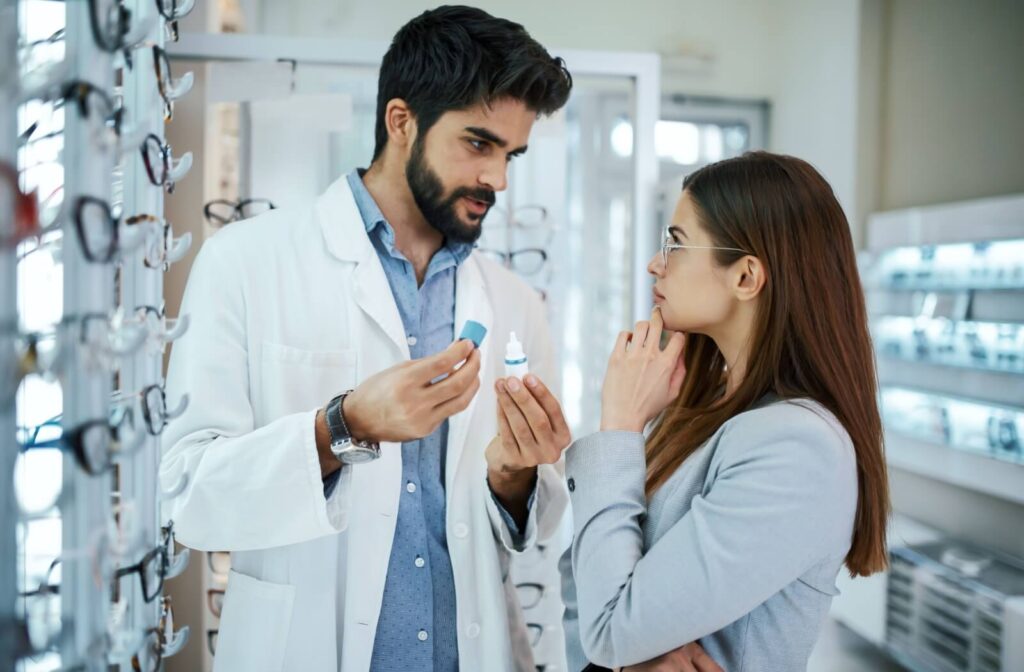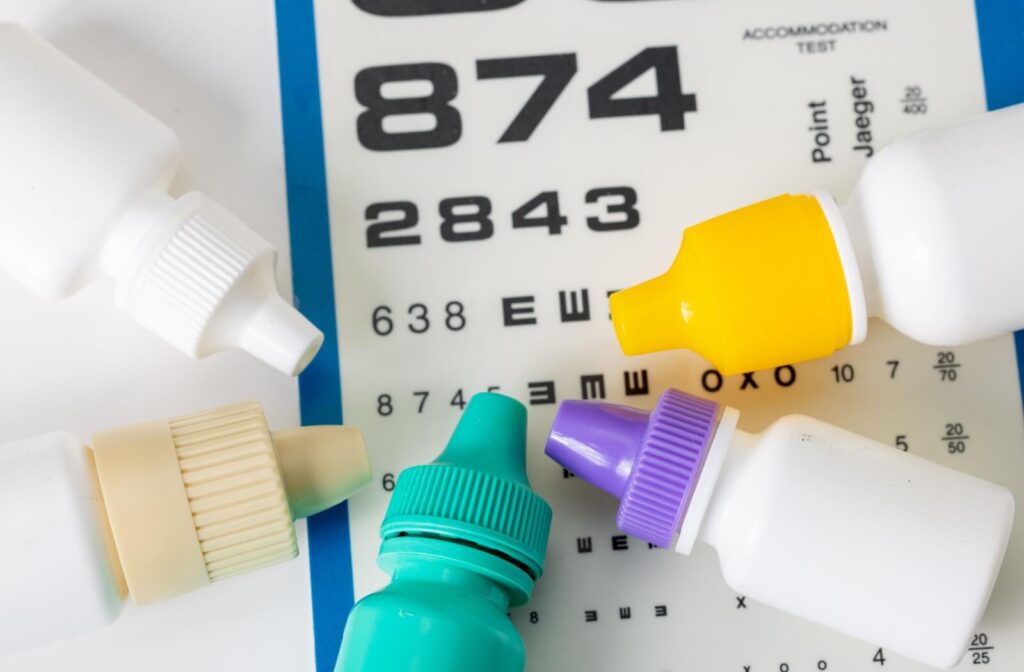Dry eyes can be uncomfortable—burning, stinging, and the constant urge to blink for relief. Over-the-counter (OTC) eye drops are enough to ease these symptoms for many. But, sometimes, prescription eye drops may become necessary to address chronic dryness or specific conditions. If you’re unsure whether you need prescription eye drops, your optometrist can provide personalized advice.
What Are Eye Drops for Dry Eyes?
Eye drops, whether OTC or prescription, are designed to provide eye moisture and lubrication. They are often called “artificial tears” because they mimic natural eye hydration. Some eye drops are lubricating, while others may address specific dryness causes, such as inflammation or tear production issues.
There are two primary categories of eye drops for dry eyes:
- Over-the-Counter Drops (OTC): These are readily available at pharmacies and are ideal for mild, occasional dryness. They primarily focus on lubrication and temporary relief.
- Prescription Eye Drops: These are tailored to treat underlying issues such as chronic inflammation, insufficient tear production, or more severe forms of dry eye disease (DED).
Understanding these differences can help determine the best solution for your symptoms.
When Do You Need to Use Eye Drops for Dry Eyes?
Eye drops for dry eyes are commonly used when your eyes feel uncomfortable or irritated. But the frequency and type of eye drops you’ll need depend on the severity of your condition. Here are some common signs that indicate you might benefit from using eye drops:
- Stinging or burning sensations
- Redness or itchiness in the eyes
- A feeling of grittiness as though there’s sand in your eyes
- Sensitivity to light
- Blurred and/or fluctuating vision or difficulty focusing
- Discomfort when wearing contact lenses for extended periods
OTC eye drops are a good starting point if these symptoms are mild and intermittent. However, persistent symptoms that don’t improve with OTC products may require more targeted treatment through prescription eye drops.
Why Would You Need Prescription Eye Drops?
If OTC solutions no longer provide relief or if your symptoms worsen, prescription eye drops can help. These drops are typically designed to address specific root causes of dry eyes, such as inflammation or insufficient tear production. They are also formulated for conditions related to dry eyes, like meibomian gland dysfunction or Sjögren’s syndrome.
When Are Prescription Eye Drops Best?
Prescription treatments are most appropriate when you experience:
- Consistent dryness unrelieved by OTC products
- Moderate to severe dry eye disease
- Contributing medical conditions, such as autoimmune disorders
- Eye surface damage or corneal inflammation due to chronic dryness
A visit to an optometrist is essential to determine whether prescription eye drops are necessary. We can examine your eyes and discuss options for tailored treatment.
How to Get Prescription Eye Drops
Start by booking an appointment with us to get a prescription. Here’s what to expect:
- Assessment: The eye doctor will assess your symptoms and the overall health of your eyes.
- Tests: They may conduct tests to measure tear production and quality, such as the Schirmer test or tear break-up time.
- Diagnosis: If diagnosed with dry eye disease, your doctor will discuss treatment options, which may include prescription-strength solutions.
Always follow your eye care provider’s instructions when using prescription drops to ensure optimal results and minimize potential side effects.
Types of Prescription Eye Drops
There are several types of prescription eye drops available, each designed to target specific underlying causes of dry eyes:
- Anti-inflammatory Eye Drops: Reduce inflammation in the tear glands and eye surface, helping boost natural tear production. Examples include cyclosporine (Restasis) and lifitegrast (Xiidra).
- Corticosteroid Eye Drops: Used to relieve severe inflammation temporarily. Due to potential side effects, these drops should be used under careful medical supervision.
- Autologous Serum Eye Drops: Made from the patient’s blood serum, these drops are used in severe cases to promote healing and hydration.
- Tear Stimulants (Secretagogues): These encourage the production of natural tears and may be delivered as medicated eye drops or oral tablets.
- Antibiotic Eye Drops: If your dryness is related to an underlying infection or blepharitis, antibiotics may be prescribed to treat those conditions.
The type of drop prescribed will depend on your diagnosis, the severity of symptoms, and your personal medical history.
Over-the-Counter Eye Drop Alternatives

Even if prescription drops aren’t necessary, knowing your OTC options can help manage mild dryness effectively. Common types of OTC artificial tears include:
- Preservative-free drops: Ideal for frequent use to avoid irritation caused by preservatives in some formulations.
- Gel drops or ointments: Provide longer-lasting relief but may cause temporary blurred vision, so they’re better suited for nighttime use.
- Lubricating drops for contacts: Specifically designed for contact lens wearers to prevent dryness during wear.
Most pharmacies and optometry offices also carry specialized products for common causes of dry eyes, like evaporative dryness or allergies.
Other Alternatives to Find Relief for Dry Eye Symptoms
Beyond eye drops, there are additional methods to relieve dry eye symptoms:
- Lifestyle adjustments:
- Hydration: Drinking enough water throughout the day supports tear production.
- Environment: Limit exposure to dry air and wind by using humidifiers or wearing protective eyewear.
- Screen time: To reduce eye strain from screens, follow the 20-20-20 rule (look away for 20 seconds at something 20 feet away every 20 minutes).
- Warm compresses: Applying a warm compress to your eyelids can stimulate oil gland function, helping to improve the quality of your tears.
- Dietary changes: A diet rich in omega-3 fatty acids (found in fish like salmon and flaxseeds) can help improve tear quality and reduce inflammation.
- Punctal plugs: These tiny devices block tear drainage channels in your eyes, helping to retain moisture on the surface.
- Advanced treatments: For more severe cases, consult your eye doctor about advanced options, such as radio frequency treatments, which target meibomian gland dysfunction.
Find the Right Solution for Your Eyes
At Red Deer Eye Care, we can help you determine whether prescription eye drops or OTC products are right for you, based on the severity of your symptoms and the underlying cause of your dryness. Contact us today for a comprehensive eye exam and a customized treatment plan that works best for you.



